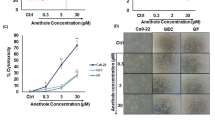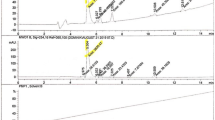Abstract
Development of oral cancer is clearly linked to the usage of smokeless tobacco. The molecular mechanisms involved in this process are however not well understood. Toward this goal, we investigated the effect of smokeless tobacco exposure on apoptosis of oral epithelial cells. Exposure of oral epithelial cells to smokeless tobacco extract (STE) induces apoptosis in a dose-dependent manner, until a threshold level of nicotine is achieved upon which apoptosis is inhibited. 1 mM of nicotine is able to inhibit apoptosis significantly induced by STE in these oral cells. Exposure of cells to nicotine alone has no effect on apoptosis, but nicotine inhibits apoptosis induced by other agents present in STE. In this study we show that, the anti-apoptotic action of nicotine is specifically associated with down-regulation of nitric oxide (NO) production. Using specific inducers of NO, we have demonstrated that inhibition of apoptosis by nicotine is through down-regulation of NO production. Further, we observed that nicotine clearly acts as a sink of NO radicals, shown using peroxynitrite generator (SIN-1) in conjunction or absence of radical scavengers. Nicotine thus causes most damage in transformed epithelial cells as depicted by accumulation of nitrotyrosine in a 3-NT ELISA assay. Inhibition of apoptosis is a hallmark in tumor progression and propels development of cancer. It may further result in functional loss of apoptotic effector mechanisms in the transformed cells. Thus, our data clearly indicates that inhibition of NO-induced apoptosis by nicotine may lead to tobacco-induced oral carcinogenesis, and implies careful development of modalities in tobacco cessation programs.








Similar content being viewed by others
References
Benowitz NL, Jacob P, Yu L (1989) Daily use of smokeless tobacco: systemic effects. Ann Intern Med 111:112–116
Greer RO, Poulson TC, Boone ME, Lindenmuth JE, Crosby L (1986) Smokeless tobacco-associated oral changes in juvenile adult and geriatric patients: clinical and histomorphologic features [published erratum appears in Gerodontics 1987 3:55]. Gerodontics 2:87–98
Grady D, Greene J, Daniels TE, Ernster VL, Robertson PB, Hauck W, Greenspan D, Greenspan J, Silverman S (1990) Oral mucosal lesions found in smokeless tobacco users. J Am Dent Assoc 121:117–123
Kaugars GE, Mehailescu WL, Gunsolley JC (1989) Smokeless tobacco use and oral epithelial dysplasia. Cancer 64:1527–1530
Hoffmann D, Adams JD, Lisk D, Fisenne I, Brunnemann KD (1987) Toxic and carcinogenic agents in dry and moist snuff. J Natl Cancer Inst. 79:1281–1286
Hoffmann D, Djordjevic MV (1997) Chemical composition and carcinogenicity of smokeless tobacco. Adv Dent Res 11:322–329
Mangipudy RS, Vishwanatha JK (1999) Role of nitric oxide in the induction of apoptosis by smokeless tobacco extract. Mol Cell Biochem 200:51–57
Sakagami H, Satoh K, Fukuchi K, Kadofuku T, Gomi K, Nakamura K, Kuribayashi N, Sunaga S, Hirota N, Iida M, Makino Y, Kojima T, Shimura H, Takeda M (1997) Effect of methionine depletion on growth and apoptosis in various tumor cell lines. Anticancer Res 17:2407–2410
Sakagami H, Kuribayashi N, Iida M, Sakagami T, Takeda M, Fukuchi K, Gomi K, Ohata H, Momose K, Kawazoe Y et al (1995) Induction of DNA fragmentation by tannin- and lignin-related substances. Anticancer Res 15:2121–2128
Kerr JF, Winterford CM, Harmon BV (1994) Apoptosis—Its significance in cancer and cancer therapy [published erratum appears in Cancer 1994 73:3108]. Cancer 73:2013–2026
Des RC, Dische S, Saunders MI (1992) The problem of cigarette smoking in radiotherapy for cancer in the head and neck. Clin Oncol R Coll Radiol 4:214–216
Browman GP, Wong G, Hodson I, Sathya J, Russell R, McAlpine L, Skingley P, Levine MN (1993) Influence of cigarette smoking on the efficacy of radiation therapy in head and neck cancer [see comments]. N Engl J Med 328:159–163
Heusch WL, Maneckjee R (1998) Signalling pathways involved in nicotine regulation of apoptosis of human lung cancer cells. Carcinogenesis 19:551–556
Maneckjee R, Minna JD (1994) Opioids induce while nicotine suppresses apoptosis in human lung cancer cells. Cell Growth Differ 5:1033–1040
Wright SC, Zhong J, Larrick JW (1994) Inhibition of apoptosis as a mechanism of tumor promotion. FASEB J 8:654–660
Oh JS, Cherrick HM, Park N-H (1990) Effect of snuff extract on the replication and synthesis of viral DNA and proteins in cells infected with herpes simplex virus. J Oral Maxillofac Surg 48:373–379
Li SL, Kim MS, Cherrick HM, Park NH (1992) Low p53 level in immortal non-tumorigenic oral keratinocytes harboring HPV-16 DNA. Eur J Cancer B Oral Oncol 28:129–34
Lekic P, Rojas J, Birek C, Tenenbaum H, McCulloch CAG (2001) Phenotypic comparison of periodontal ligament cells in vivo and in vitro. J Periodontal Res 36:71–79
Frenkel K, Gleichauf C (1991) Hydrogen peroxide formation by cells treated with a tumor promoter Free Radic Res Commun 12–13:783–794
Hoffmann D, Adams JD, Lisk D, Fisenne I, Brunnemann KD (1987) Toxic and carcinogenic agents in dry and moist snuff. J Natl Cancer Inst 79:1281–1286
Hoffmann D, Adams JD, Brunnemann KD, Rivenson A, Hecht SS (1982) In tobacco specific N-nitrosamines: occurrence and bioassays, IARC Sci Publ, pp 309–318
Hoffmann D, Adams JD (1981) Carcinogenic tobacco-specific N-nitrosamines in snuff and in the saliva of snuff dippers. Cancer Res 41:4305–4308
Reiter CD, Teng RJ, Beckman JS (2000) Superoxide reacts with nitric oxide to nitrate tyrosine at physiological pH via peroxynitrite. J Biol Chem 275:32460–32466
Radi R (2004) Nitric oxide oxidants and protein tyrosine nitration. Proc Natl Acad Sci USA 101:4003–4008
Yamaguchi Y, Okabe K, Matsumura F, Akizuki E, Matsuda T, Ohshiro H, Liang J, Yamada S, Mori K, Ogawa M (1999) Peroxynitrite formation during rat hepatic allograft rejection. Hepatology 29:777–784
Wright SC, Zhong J, Zheng H, Larrick JW (1993) Nicotine inhibition of apoptosis suggests a role in tumor promotion. FASEB J 7:1045–1051
Yan GM, Lin SZ, Irwin RP, Paul SM (1995) Activation of muscarinic cholinergic receptors blocks apoptosis of cultured cerebellar granule neurons. Mol Pharmacol 47:248–257
Kerr JF, Winterford CM, Harmon BV (1994) Apoptosis-its significance in cancer and cancer therapy. [published erratum appears in Cancer 1994 73:3108] Cancer 73:2013–2026
Blank KR, Rudoltz MS, Kao GD, Muschel RJ, McKenna WG (1997) The molecular regulation of apoptosis and implications for radiation oncology. Int J Radiat Biol 71:455–466
Blandino G, Strano S (1997) BCL-2: the pendulum of the cell fate. J Exp Clin Cancer Res 16:3–10
Tang DG, Porter AT (1997) Target to apoptosis: a hopeful weapon for prostate cancer. Prostate 32:284–293
Wright SC, Zhong J, Larrick JW (1994) Inhibition of apoptosis as a mechanism of tumor promotion. FASEB J 8:654–660
Des RC, Dische S, Saunders MI (1992) The problem of cigarette smoking in radiotherapy for cancer in the head and neck. Clin Oncol R Coll Radiol 4:214–216
Browman GP, Wong G, Hodson I, Sathya J, Russell R, McAlpine L, Skingley P, Levine MN (1993) Influence of cigarette smoking on the efficacy of radiation therapy in head and neck cancer [see comments]. N Engl J Med 328:159–163
Mangipudy RS, Vishwanatha JK (1999) Role of nitric oxide in the induction of apoptosis by smokeless tobacco extract. Mol Cell Biochem 200:51–57
Nicotera P, Brune B, Bagetta G (1997) Nitric oxide: inducer or suppressor of apoptosis? Trends Pharmacol Sci 18:189–190
Shen YH, Wang X, Wilcken DE (1998) Nitric oxide induces and inhibits apoptosis through different pathways. FEBS Lett 433:125–131
Xie K, Fidler IJ (1998) Therapy of cancer metastasis by activation of the inducible nitric oxide synthase. Cancer Metastasis Rev 17:55–75
Wink DA, Kasprzak KS, Maragos CM, Elespuru RK, Misra M, Dunams TM, Cebula TA, Koch WH, Andrews AW, Allen JS et al (1991) DNA deaminating ability and genotoxicity of nitric oxide and its progenitors. Science 254:1001–1003
Nguyen T, Brunson D, Crespi CL, Penman BW, Wishnok JS, Tannenbaum SR (1992) DNA damage and mutation in human cells exposed to nitric oxide in vitro. Proc Natl Acad Sci USA 89:3030–3034
deRojas WT, Tamir S, Ji H, Wishnok JS, Tannenbaum SR (1995) Nitric oxide induces oxidative damage in addition to deamination in macrophage DNA. Chem Res Toxicol 8:473–477
Gal A, Wogan GN (1996) Mutagenesis associated with nitric oxide production in transgenic SJL mice. Proc Natl Acad Sci USA 93:15102–15107
Fehsel K, Kroncke KD, Meyer KL, Huber H, Wahn V, Kolb BV (1995) Nitric oxide induces apoptosis in mouse thymocytes. J Immunol 155:2858–2865
Geng YJ, Hellstrand K, Wennmalm A, Hansson GK (1996) Apoptotic death of human leukemic cells induced by vascular cells expressing nitric oxide synthase in response to gamma-interferon and tumor necrosis factor-alpha. Cancer Res 56:866–874
Fukuo K, Hata S, Suhara T, Nakahashi T, Shinto Y, Tsujimoto Y, Morimoto S, Ogihara T (1996) Nitric oxide induces upregulation of Fas and apoptosis in vascular smooth muscle. Hypertension 27: 823–826
Melino G, Bernassola F, Knight RA, Corasaniti MT, Nistico G, Finazzi AA (1997) S-nitrosylation regulates apoptosis [letter]. Nature 388:432–433
Gansauge S, Nussler AK, Beger HG, Gansauge F (1998) Nitric oxide-induced apoptosis in human pancreatic carcinoma cell lines is associated with a G1-arrest and an increase of the cyclin-dependent kinase inhibitor p21WAF1/CIP1. Cell Growth Differ 9: 611–617
Tamatani M, Ogawa S, Niitsu Y, Tohyama M (1998) Involvement of Bcl-2 family and caspase-3-like protease in NO-mediated neuronal apoptosis. J Neurochem 71:1588–1596
Iwashina M, Shichiri M, Marumo F, Hirata Y (1998) Transfection of inducible nitric oxide synthase gene causes apoptosis in vascular smooth muscle cells. Circulation 98:1212–1218
Ho YS, Lee HM, Mou TC, Wang YJ, Lin JK (1997) Suppression of nitric oxide-induced apoptosis by N-acetyl-l-cysteine through modulation of glutathione, bcl-2 and bax protein levels. Mol Carcinog 19:101–113
Kim YM, Talanian RV, Billiar TR (1997) Nitric oxide inhibits apoptosis by preventing increases in caspase-3-like activity via two distinct mechanisms. J Biol Chem 272:31138–31148
Tzeng E, Billiar TR, Williams DL, Li J, Lizonova A, Kovesdi I, Kim YM (1998) Adenovirus-mediated inducible nitric oxide synthase gene transfer inhibits hepatocyte apoptosis. Surgery 124:278–283
Nussler AK, Billiar TR (1993) Inflammation immunoregulation and inducible nitric oxide synthase. J Leukoc Biol 54:171–178
Morris SMJ, Billiar TR (1994) New insights into the regulation of inducible nitric oxide synthesis. Am J Physiol 266:E829–E839
Kim YM, Kim TH, Chung HT, Talanian RV, Yin XM, Billiar TR (2000) Nitric oxide prevents tumor necrosis factor alpha-induced rat hepatocyte apoptosis by the interruption of mitochondrial apoptotic signaling through S-nitrosylation of caspase-8. Hepatology 32:770–778
So HS, Park RK, Kim MS, Lee SR, Jung BH, Chung SY, Jun CD, Chung HT (1998) Nitric oxide inhibits c-Jun N-terminal kinase 2 (JNK2) via S-nitrosylation. Biochem Biophys Res Commun 247: 809–813
Mei JM, Hord NG, Winterstein DF, Donald SP, Phang JM (2000) Expression of prostaglandin endoperoxide H synthase-2 induced by nitric oxide in conditionally immortalized murine colonic epithelial cells. FASEB J 14:1188–1201
Bell JE, Maines MD (1988) Kinetic properties and regulation of biliverdin reductase. Arch Biochem Biophys 263:1–9
Sheng H, Shao J, Morrow JD, Beauchamp RD, DuBois RN (1998) Modulation of apoptosis and Bcl-2 expression by prostaglandin E2 in human colon cancer cells. Cancer Res 58:362–366
Subbaramaiah K, Zakim D, Weksler BB, Dannenberg AJ (1997) Inhibition of cyclooxygenase: a novel approach to cancer prevention. Proc Soc Exp Biol Med 216:201–210
Banerjee AG, Gopalakrishnan VK, Bhattacharya I, Vishwanatha JK (2002) Deregulated cyclooxygenase-2 expression in oral premalignant tissues. Mol Cancer Ther 1:1265–1271
Origuchi T, Migita K, Nakashima T, Honda S, Yamasaki S, Hida A, Kawakami A, Aoyagi T, Kawabe Y, Eguchi K (2000) Regulation of cyclooxygenase-2 expression in human osteoblastic cells by N-acetylcysteine. J Lab Clin Med 136:390–394
Acknowledgments
Research described in this article was supported by a grant from the RMG, PM International to JKV. We are thankful to Drs. Wong DTW and Lekic PC for the gift of valuable cell lines for our research, and technical assistance by Ms. Judy Kanungo (AGB lab), Ms. Petrina Setiloane (AGB Lab), and Mr. Randall Davis (JKV lab).
Author information
Authors and Affiliations
Corresponding author
Additional information
Abhijit G. Banerjee and Velliyur K. Gopalakrishnan—contributed equally.
Rights and permissions
About this article
Cite this article
Banerjee, A.G., Gopalakrishnan, V.K. & Vishwanatha, J.K. Inhibition of nitric oxide-induced apoptosis by nicotine in oral epithelial cells . Mol Cell Biochem 305, 113–121 (2007). https://doi.org/10.1007/s11010-007-9534-2
Received:
Accepted:
Published:
Issue Date:
DOI: https://doi.org/10.1007/s11010-007-9534-2




